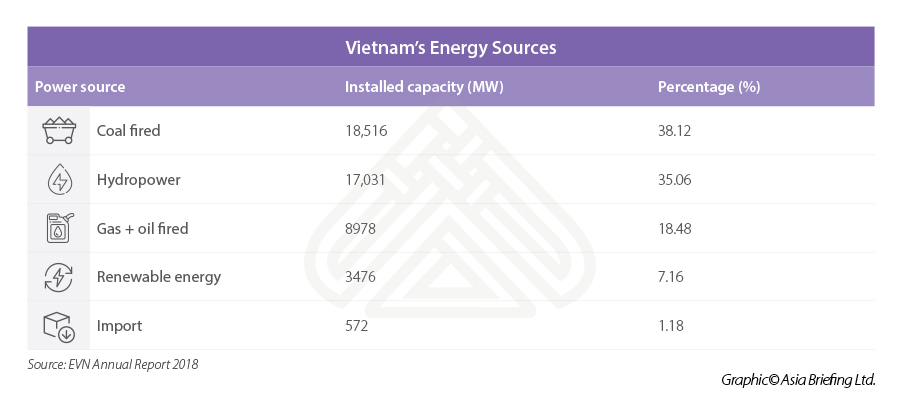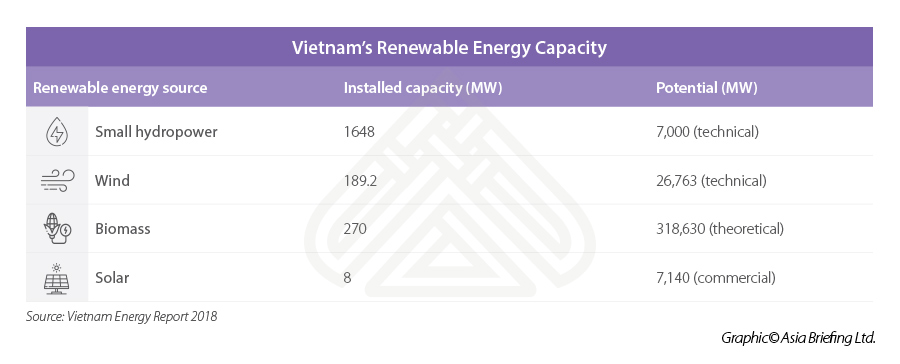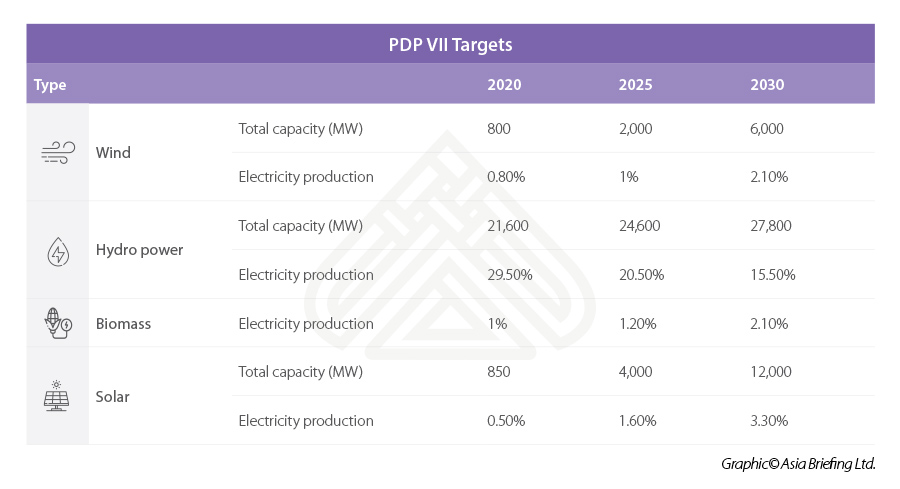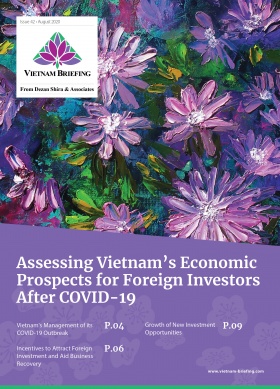Renewables in Vietnam: Current Opportunities and Future Outlook
This article is part of our partnership with the Green Economy Forum & Exhibition 2022, organized by EuroCham Vietnam, supported by Dezan & Associates Vietnam.
- Vietnam’s renewable energy sector is one of the most vibrant in Southeast Asia presenting significant opportunities for investors.
- With electricity demand projected to continue increasing, the government has implemented several policies to ensure Vietnam is on track to meet demand.
- Investors interested in this market should consider the renewable energy sector and make long term plans to ensure viability.
Vietnam is one of the most efficient power markets in Southeast Asia, driven by low-cost resources such as hydro and coal. The country has achieved around 99 percent electrification with relatively low cost in comparison to neighboring countries.
With electricity demand projected to increase by eight percent annually until 2025, the government is moving forward to develop renewable energy sources to ensure energy security and addressing the growing power demand.
Supply and future demand
Supply
Energy sources are diverse in Vietnam, ranging from coal, oil, natural gas, hydropower, and renewable energy. The total installed capacity as of November 2018 was 47,750MW.
According to the 2018 Vietnam Electricity Annual Report, hydropower and coal-fired power led among power generation sources followed by gas and renewable energy.
Demand
With growing industrialization and economic modernization, energy demand is predicted to increase by over eight percent per annum during the 2021-2030 period.
The demand is expected to increase from 265-278 TWh in 2020 to 572-632 TWh in 2030.
To meet the growing demand, Vietnam needs 60,000MW of electricity by 2020, 96,500MW by 2025, and 129,500MW by 2030. To do so, the country needs to increase its installed capacity by 6,000MW – 7,000MW annually and spend close to US$148 billion by 2030.
As for the renewable energy sector, the funding required would be around US$23.7 billion by 2030. For energy efficiency, a further US$1.5 – US$3.6 billion would be required during the same period, according to a report by the United Nations Development Programme.
Renewable energy – current state and potential
At present, hydropower holds the largest share amongst all renewable energy sources, followed by wind and biomass. Solar energy, biogas, and waste-to-energy technologies are picking up slowly while geothermal energy and tidal energy are at a very early stage.
The government aims to increase the electricity output produced from renewable sources from approximately 58 billion kWh in 2015 to 101 billion kWh by 2020, and 186 billion kWh by 2030.
Government targets 2020-2030 for its energy needs
In 2016, the government approved the revised National Power Development Master Plan (“PDP VII”) for the 2011- 2020 Period, with a vision for 2030. The next PDP VIII is expected to be released sometime in 2020.
The PDP VII plan aims to increase the share of renewable energy to around seven percent by 2020 and above 10 percent by 2030 and reduce the use of imported coal-fired electricity to ensure energy security, climate change mitigation, environmental protection, and sustainable socio-economic development.
The targets set in PDP VII for renewable energy for 2020, 2025, and 2030 are:
Investments in renewables
Solar
Major investors in Vietnam in the approval, construction, or completion stage include German ASEAN Power, B.Grimm Power Public Co Ltd, Trina Solar, Schletter Group, JA Solar, Sunseap International, Nippon Sheet Glass, Ecoprogetti, Tata Power, Shapoorji Pallonji Infrastructure Capital, Gulf Energy Development, InfraCo Asia Development, and ACWA Power.
Although there is no foreign ownership restriction in the industry, PPP projects in the form of build-operate-transfer (BOT) contracts are usually preferred due to government guarantees and incentives.
Wind
In the wind energy sector, the major investors include GE Renewable Energy, Mainstream Renewable Power, Phu Cuong Group, Blue Circle, Superblock Pcl, Siemens Gamesa, Doosan Heavy, Egeres Enerji, and Tan Hoan Cau Corp.
Investor challenges
Although foreign and domestic investment is on the rise in the renewable energy sector, much more needs to be done to ease investor concerns.
In spite of the liberalization of the policies in the last few years, investors are facing numerous obstacles such as:
- Lack of capital/funding;
- Low tariffs coupled with high investment costs in newer technologies;
- Lack of qualified human resources;
- Underdeveloped supporting industries;
- Weak grid capacity;
- Un-bankable power purchasing agreements (PPA) terms;
- Delays in larger projects due to the complex regulatory framework; and
- Lack of clarity in future energy prices.
Feed-in-tariffs
Feed-in-tariffs in Vietnam is one of the lowest in the world. State-owned Electricity Vietnam (EVN) purchases all power from renewable projects. Tariffs are currently set for biomass, wind, waste-to-energy, and solar projects.
- Wind
VND 1,928/ kWh (US cents 8.5 per kWh) for onshore;
VND 2,223/kWh (US cents 9.8 per kWh) for offshore;
- Solid waste-to-energy
US cents 7.28 per kWh (burning of gases from landfills);
US cents 10.05 per kWh (direct burning);
- Solar
Floating solar energy projects: US cents 7.69 per kWh.
Ground-mounted solar energy projects: US cents 7.09 KWh.
Rooftop energy solar projects: US cents 8.38
- Biomass
US cents 7.03 per kWh (Combined Heat Power Technology)
US cents 8.47 per kWh (avoided cost tariff for other technologies)
- Small hydropower (below 30 MW)
Subject to avoided costs regime (US cents 5 per kWh)
Investment considerations
Vietnam would require around US$10 billion annually between now and 2030 to keep pace with the growing demand. With such high capital requirements, the government has allowed 100 percent foreign ownership of Vietnamese companies in the energy sector. Foreign investors can choose among permitted investment forms; 100 percent foreign-invested company, joint venture or public-private partnership (PPP) in the form of a BOT contract.
With low feed-in-tariffs and high production costs, PPP is the most effective means of entering the market to minimize risks. PPP term is 20 years from the commercial operation date.
Renewable energy projects benefit from import duty exemption for imported goods to establish fixed assets, materials, and semi-finished products. Tax incentives include preferential corporate income tax (CIT) rate of 10 percent for 15 years; CIT exemption for four years and a reduction of 50 percent for the following nine years.
In addition, other incentives include preferential credit loans, land use tax exemption, and land rental exemption.
To ensure consistent returns for investors, the government has also approved electricity prices (avoided-cost tariffs, Feed-in Tariff) for on-grid renewable energy, including standardized power purchase contracts (20 years) for each renewable power type. EVN, the sole buyer of electricity in Vietnam has also been mandated to prioritize renewable energy in grid connection, dispatch, and purchasing electricity at approved tariffs.
Future in renewables bright but more needs to be done
Vietnam has immense potential for wind and solar-based projects and is sufficient enough to address the growing power demands. However, low feed-in-tariffs (FiTs) have deterred foreign investors due to large investment costs. The government needs to gradually increase FiTs or at least adopt a price plan so that investors would be aware of the expected price hikes in the future. In addition, if Vietnam can introduce a bankable PPA, it could lead to an increase in international financing, which would help the country to meets its renewable energy goals.
Apart from FiTs, negotiating standard PPAs with EVN, the sole buyer of power is time-consuming, which leads to an increase in the total project costs. PPA negotiations have to be more efficient to reduce overall costs to investors due to delays. Relevant government authorities should also reduce the timeline regarding the formulation of guidelines and regulatory approvals, which in some cases has been years. Lack of clarity and delays in approvals often leads to execution delays or complete abandonment of projects.
Additionally, quality and sourcing of data for renewable energy sub-sectors have to improve to ensure clarity for investors about available locations, infrastructure capabilities, and government’s targets.
As the renewable energy sector picks up the pace in the coming decade, the government also needs to focus on developing the human resource capability. In the last few years, EVN has been conducting various training programs for technical experts, mostly for power plants and similar training should be introduced for the renewable energy sub-sectors as well, in order to meet up with new requirements.
Last but not least, supporting industries play a crucial role in the development and quicker adoption of renewable energy technologies. The government should promote domestic SMEs through capital subsidies and incentives such as tax breaks and preferential loans. A competitive supporting industry will help in reducing investment costs for renewable projects.
Note: This article was first published in March 2019, and has been updated to include the latest developments.
Vietnam Briefing is produced by Dezan Shira & Associates. The firm assists foreign investors throughout Asia from offices across the world, including in Hanoi and Ho Chi Minh City. Readers may write vietnam@dezshira.com for more support on doing business in Vietnam.
- Previous Article Challenges in Vietnam’s Manufacturing M&A
- Next Article Erneuerbare Energien in Vietnam: Aktuelle Chancen und Zukunftsaussichten











